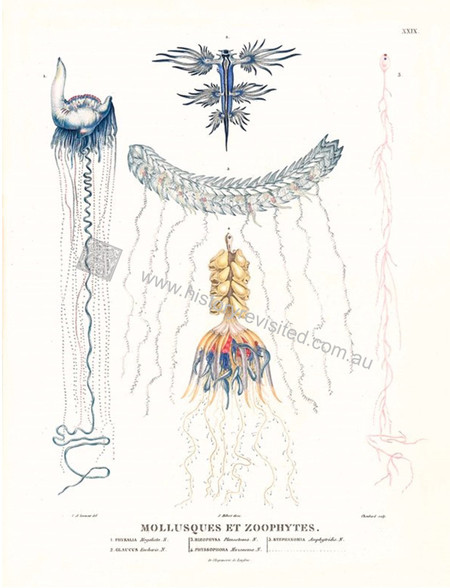 Loading... Please wait...
Loading... Please wait...All prices are in All prices are in AUD
Categories
- Home
- Giclee Prints
- Giclee Leseuer zoophytes mollusques Jellyfish French Baudin
- Home
- Giclee Prints
- Australasian Natural History
- Giclee Leseuer zoophytes mollusques Jellyfish French Baudin
- Home
- Giclee Prints
- Australasian Natural History
- French Natural History 1800s
- Giclee Leseuer zoophytes mollusques Jellyfish French Baudin
Product Description
Giclee, Archival, Natural History, Science, Zoophytes, Nicolas Baudin, Charles Leseuer, Age of Enlightenment,Voyage of Exploration, Marine, Oceanography
"Plate 29-Mollusques et Zoophytes"
1. Physalia Megalista (Portugese Man-of-War/Australia Blue Bottle) 2. Glaucus Eucharis (Blue Sea Slug) 3. Rizphysa Planestoma 4. Physophora Muzonema (Bubble Jelly) 5. Stephanomia Amphytridis
Approximate size of portrait images = 21 cm x 30 cm (8 1/4 x 12 in)
Archival Edition Limited to 200 each image.
Issued with numbered certificate.
Description of Plate 29: This plate is a celebration of Zoophytes, a little understood curiosity whose habitat was largely unexplored until the 1700s & 1800s. It was Nicolas Baudin was wrote in his personal Journal of the "zoophytes" featured here,"...without a doubt, when people see them they will have great difficulty believing that such creatures exist, for with many we have found greater similarities to a beautiful flower than to a living animal..." Baudin identified the perplexing conundrum that the growing world of Science was discovering, that organisms can blur the line between animal and plant classifications. The star specimen on Plate 29 is No.1 Physalia Megalista, or Portuguese Man of War, on the left, with its long trail of toxic physiologically integrated colonies. It represents a community of organisms, most notoriously the venomous microscopic "nematocysts", that deliver a powerful sting to kill fish, and occasionally humans. They may look like a jellyfish, but it is a "siphonophore". On the right (No 3) is Rizphysa planesoma (classified by Francois Peron & Leseuer in 1807), an elegant & delicate soft pink worm-like frayed thread with a small transparent oval "head" with two lapis blue dots either side of a red dot. Between these specimens is a symmetrical laid out body of No 2. Glaucus Eucharis (Blue Sea Slug), its body is tapered with three pairs of feathered "fans" descending in size, either side. No. Physophora muzonema, or Bubble Jelly, has translucent yellow sacks attached to a trunk with a "flower" of tentacles sheltering finer red, yellow and blue colony-tendrils within. It is highly toxic. No 5 Stephanomia amphytridis, is another siphonophore growing up to 10 meters long. it was originally named by the artists Leseuer and Petit in 1807.
The colors that predominate are translucent blue, pink and yellow.
Historical Context: The antique technique chosen to tackle the conveyance of challenging translucency was the an invention of the great botanical artist, Pierre-Joseph Redoute, a la Poupee, printed with color inks. Although he invented this printing with colored inks to convey vibrancy to his exquisite botanical illustrations, here it was employed to convey the "impossible translucency" of these creatures when published in the natural history volumes after the voyage's return. The Captain had been challenged by the mix of challenging personalities aboard this momentous voyage due to the political allegiances, class divides, personal agendas of Artists versus Scientists: while artists objective is to record natural history, scientists is to carve it up to discover its mechanics. Among this melee of differing objectives, Baudin had taken on two untested, but talented, young artists, Charles-Alexander Lesueur and Nicolas-Martin Petit, as assistant gunners. However, it has been suspected that it had been his wish to create an autonomous celebration of the unknown anticipated natural history treasures. When the official artist jumped ship at Mauritius, it is these two young men's whose legacy we are celebrating here. Their drawings and paintings of birds, animals and marine creatures are among the most historically important and beautiful records of 19th century discovery. Indeed Zoophytes, as they were known then, were nature's puzzle. The inventor of Taxonomy, Carl Linnaeus states in "The System Naturae", 1758, there are three states of being in the Kingdom of Nature- Rocks, Animals and Plants. Problem was that zoophytes defied this system of classification, as they represented "a composite small organism, with both animal and plant characteristics” Linnaeus wrote to John Ellis, the first to describe the Venus Flytrap, "zoophytes have a mere vegetable life…therefore vegetables with flowers like small animals…the Creator has been pleased that they should receive nourishment by their naked flowers…which we call a mouth”. It is against this academic that the voyages of discovery made their observations to further investigate the conundrum, as we see here.
© Sandra J Ker 2023
Product Videos
-
 The deadly ten...Subscribe and ? to the BBC ? https://bit.ly/BBCYouTubeSub Watc...
The deadly ten...Subscribe and ? to the BBC ? https://bit.ly/BBCYouTubeSub Watc... -
 Facts: The Blu...Quick facts about this tiny stinging nudibranch! The blue sea ...
Facts: The Blu...Quick facts about this tiny stinging nudibranch! The blue sea ...














